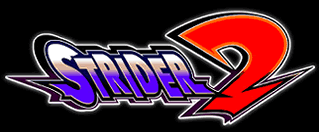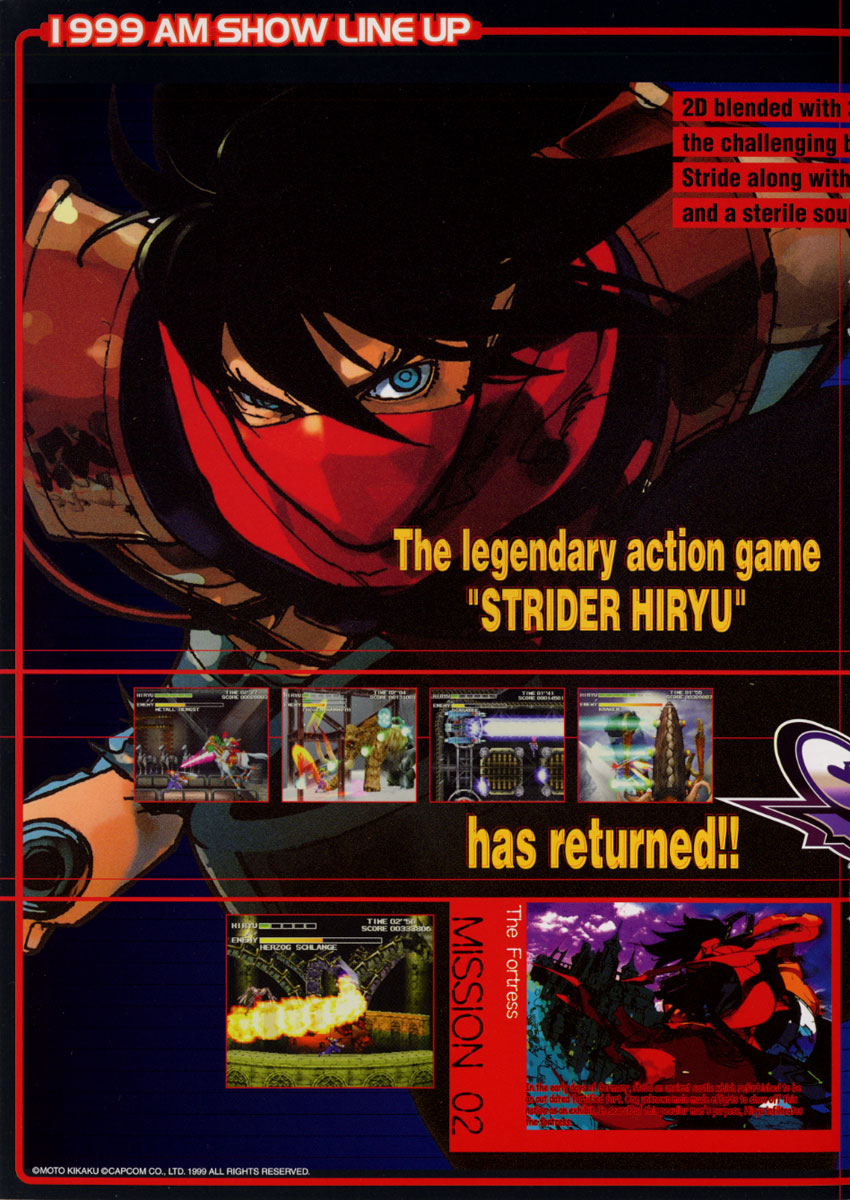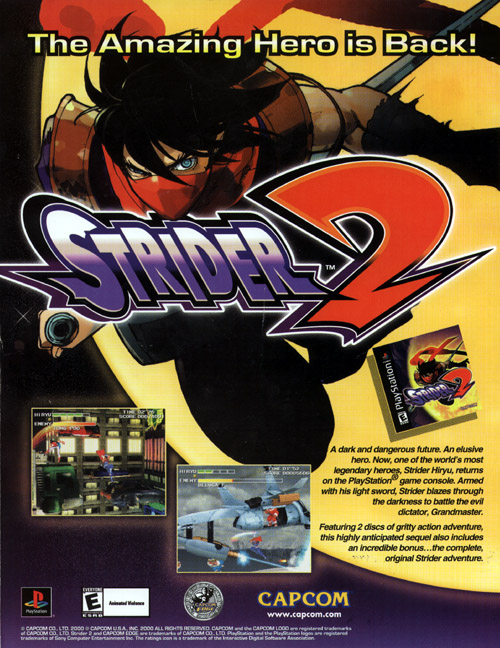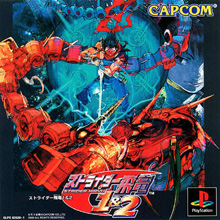Review | Screenshots | Dialogue | Concept Art | Secret File #26 | Merchandise | End Credits
Strider 2

E3 1999 initially shaped up to be just like any other. The same game developers rented their booths like they did every year. The same industry insiders prepared to make the rounds. But in 1999, things were different. Capcom had something up their sleeves.
Capcom unveiled the first playable demo of Strider 2 at E3, marking Hiryu's triumphant return. Earlier in the year, a grainy video had given a tantalizing glimpse of what the true sequel to Capcom's CPS-1 hit had to offer, but E3 provided demonstrable facts. And later that winter, Capcom's flyers for the 1999 JAMMA Amusement Machine Show spoke of even more details, revealing the game's story and setting along with new screenshots and concept art from Shoei and Harumaru.


For the title Strider 2 was a bit of a misnomer. There had been two sequels to the CPS-1 game, prior to this announcement: an official Capcom release for the NES, and an unofficial one by U.S. Gold and Tiertex. The latter had actually borne the title "Strider II" in some countries. Unlike the poorly-cobbled-together Strider Returns, however, this new Strider 2 came from Capcom, ignoring U.S. Gold's reviled effort.
This new sequel was an almost direct homage to the first game. Hiryu's appearance had been updated to the now-familiar look from Marvel vs. Capcom and he boasted several new abilities. In addition to the aerial acrobatics from the first game, he could now dash, double-jump, and launch himself off of walls. The robot helpers were gone, but in their place were new special moves: "Midare-Giri" (Savage Slash), which deployed 360° flurry of debuffing cypher slashes; and "Boost", a timed power-up that increased attack damage while hurling homing energy blades at Hiryu's enemies.

Most of the characters in the game (including Hiryu) are 2D animated sprites, and the gameplay itself is traditional sidescrolling platforming. Its stages are fresh and vibrant updates of the ones from the 1989 coin-op, and are rendered in 3D, panning and rotating around Hiryu as he moves through them. All told, Strider 2 has five stages:
MISSION 01 |
Neo Hong Kong City |
MISSION 02 |
Fortress Wahnen |
MISSION 03 |
The Antarctic Ross Ice Shelf |
MISSION 04 |
The Flying Battleship Balrog |
MISSION 05 |
The Third Moon |
Strider 2 takes place in a future where Grandmaster Meio rules the world. An unnamed rogue faction (that fanon has unofficially dubbed "Light Sword Cypher") works behind the scenes with the Grandmaster's despotic global government, enforcing his will. Hiryu must once again overthrow the Grandmaster and save humanity.
The game is not without its flaws. Many have criticized Strider 2 for not living up to its hype, citing slowdown, choppy level flow, and a continue system that drops you where you die among its fatal flaws. The English version also has no voiceovers during the cutscenes. Capcom didn't re-record the Japanese dialogue. The English translation is a bit lacking, as well, leading many (including myself) to assume that Meio's "2000 years ago" line at the very end was just a localization error. It is not. Careful examination of the Japanese dialogue reveals that Strider 2 does indeed take place 2000 years after Strider, apparently. (Thank Rodrigo Shin for that revelation.)
 I can't help but love it, though. It's a much, MUCH better game than Strider Returns. It's an anachronistic example of old-school gaming, and one of the few games in the late 90's that didn't hop on board the "next gen" bandwagon and go overkill on the 3D graphics.
I can't help but love it, though. It's a much, MUCH better game than Strider Returns. It's an anachronistic example of old-school gaming, and one of the few games in the late 90's that didn't hop on board the "next gen" bandwagon and go overkill on the 3D graphics.
Consider. Strider 2 does not recycle any sprites from previous Capcom games. Never once in the game do the controls feel awkward. The speed is comparable to the original arcade game, unless you're using the Boost function. It tries ever so hard to meld the two disparate continuities of both its predecessor and the manga/NES game. And it effectively reencapsulates the visceral thrill of destroying legions of baddies all for the sole purpose of bragging rights on the high-score board.
On that note, anyone who hasn't yet managed to get at least one "Secret Bonus" on this game doesn't have any right to complain about Strider 2's difficulty. By all rights, this game should not exist. The mere fact that it does is reason to celebrate.
The following summer, Avalon Entertainment produced a faithful (if not overly spectacular) port for the Sony PlayStation. Avalon's 2-disc set included a bonus disc containing a pixel-perfect translation of the CPS-1 game, making it the closest thing to a "Strider Collection" release that Capcom's ever put out. It's a must-buy for any Strider fan.
 Additionally, the PSX port included a bonus level: Mission 00, the "waterfall level". In order to play Mission 00, you have to beat the bundled port of the 1989 coin-op and save it onto a memory card. This will unlock the waterfall level. Also, in the course of the game, Hiryu encounters a rogue Strider named Hien (飛燕, meaning "flying swallow"), who is unlockable as a playable character after the player beats Strider 2. Hien's weapon is a double-ended "Valkyrie" cypher which he can throw like a boomerang. His attacks are more powerful than Hiryu's, but he can only throw two blades at a time (unless his cypher is powered up and he's granted a third). Once both of them are in flight, he is defenseless. Beat the game with him to unlock "Infinite Boost" on Strider 2's Options Menu.
Additionally, the PSX port included a bonus level: Mission 00, the "waterfall level". In order to play Mission 00, you have to beat the bundled port of the 1989 coin-op and save it onto a memory card. This will unlock the waterfall level. Also, in the course of the game, Hiryu encounters a rogue Strider named Hien (飛燕, meaning "flying swallow"), who is unlockable as a playable character after the player beats Strider 2. Hien's weapon is a double-ended "Valkyrie" cypher which he can throw like a boomerang. His attacks are more powerful than Hiryu's, but he can only throw two blades at a time (unless his cypher is powered up and he's granted a third). Once both of them are in flight, he is defenseless. Beat the game with him to unlock "Infinite Boost" on Strider 2's Options Menu.
Compared to the arcade, Avalon Entertainment's PSX port is lacking some frames of animation; however, the ZN-2 arcade board this game ran on was simply a more advanced PlayStation board. The only difference between the two was that the ZN-2 had more RAM and a better graphics card. In theory, playing the PSX port on a PS2 would provide a near-arcade experience, but this isn't quite so. Nothing can make up for the missing animation frames.
Also, there seems to have been some kind of printing error at the American manufacturing plant, because every single NTSC copy of Strider 2 I've run across has mislabeled discs: the Strider 2 disc is labeled Strider and vice versa. The Japanese version, however, is printed correctly.
Strider 2 may have fallen short of its CPS-1 predecessor, but that's only because the bar was set so high. Compared to the other games in the series, this installment is a breath of fresh air.
Review | Screenshots | Dialogue | Concept Art | Secret File #26 | Merchandise | End Credits